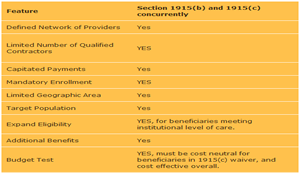Using Concurrent Authorities
If you want your program to feature mandatory enrollment, or you want to conduct a competitive procurement from among a number of qualified potential contractors, you will need to consider an alternative set of concurrent authorities. You could consider using the statutory managed care authority under section 1932(a), but recall that Medicare-Medicaid beneficiaries, children with special needs, and Indians are all exempt from mandatory enrollment under 1932(a). If you want a mandatory program that includes any or all of those groups, you may want to consider concurrent 1915(b) and (c) waivers, the features of which are shown in Table 5.G.
Table 5.G. Section 1915 (b) and 1915(c) concurrently
In addition to allowing mandatory enrollment and selective contracting, these concurrent authorities are different from the concurrent 1915(a) and (c) authorities:
- Additional benefits may still be provided to achieve flexible services, but the authority for such benefits is provided within Section 1915(b).
- Two budget tests must be met, one for each waiver. Separate reporting is required for each waiver, though the ACA aligned the approval period of the two authorities to allow for reporting and renewal on a uniform schedule.


